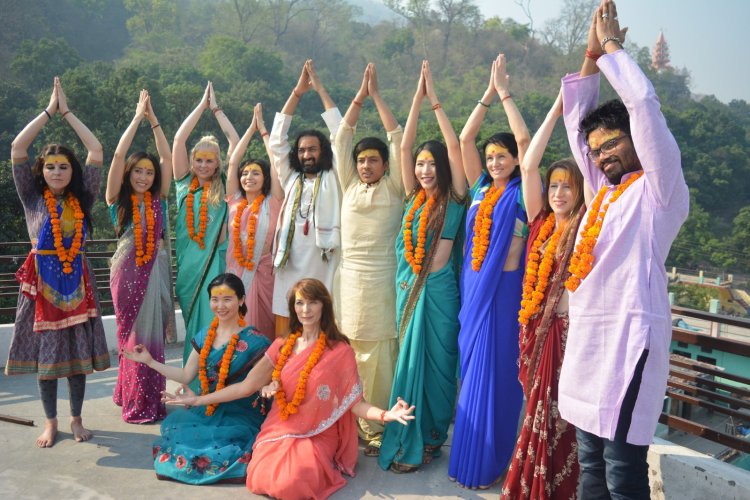The Powerful Synergy of Yin & Yoga: A Deep Dive into Restorative Practices
Incorporating Yin & Yoga into your routine can offer a harmonious balance of strength, flexibility, and deep relaxation. This powerful combination promotes both physical healing and emotional well-being. Whether you are looking to enhance your flexibility, reduce stress, or develop a more mindful yoga practice, Yin Yoga offers a slower, more contemplative approach that complements faster-paced yoga styles perfectly. If you’ve been feeling mentally scattered or physically tight, give Yin & Yoga a try. The slow-paced, deep-stretching practice might just be the missing piece to your yoga journey, leading to more profound healing, peace, and inner balance.
Share this Post to earn Money ( Upto ₹100 per 1000 Views )

In the ever-evolving world of modern yoga, one practice stands out for its emphasis on deep relaxation, patience, and the nurturing of both body and mind Yin & Yoga This beautiful fusion offers a balanced approach to fitness, mental clarity, and emotional healing. While yoga is often associated with dynamic, flowing sequences, Yin Yoga provides a more meditative, slow-paced, and introspective experience.
In this blog, we’ll explore the essence of Yin & Yoga, its benefits, and why it might just be the perfect complement to your regular yoga routine.
What is Yin & Yoga?
Yin Yoga is a quiet, slow-paced practice that focuses on holding postures for extended periods, typically 3-5 minutes or longer. Unlike more active forms of yoga such as Vinyasa or Ashtanga, which emphasize muscle engagement and dynamic movement, Yin Yoga targets the deep connective tissues of the body, including ligaments, tendons, and fascia. It’s a practice designed to enhance flexibility, restore energy, and promote deep relaxation.
Yin & Yoga refers to the combination of Yin Yoga with other forms of yoga, creating a well-rounded practice. This hybrid approach allows practitioners to experience both the energy-boosting and strength-building elements of more active styles like Hatha, Vinyasa, or Ashtanga, while also benefiting from the restorative, meditative elements of Yin.
The Core Principles of Yin Yoga
To understand why Yin & Yoga works so harmoniously, it's important to know what makes Yin Yoga distinct:
-
Longer Holds: In Yin Yoga, you typically hold poses for 3-5 minutes or longer. This extended time allows the body to relax deeper into the posture, releasing tension and working on deeper tissues.
-
Targeting Deep Connective Tissues: While traditional yoga focuses on stretching muscles, Yin Yoga targets the deeper layers of connective tissues. The longer hold times encourage the release of fascial tension, promoting flexibility and joint mobility.
-
Mindful Stillness: Yin Yoga encourages stillness, allowing practitioners to turn inward and focus on their breath. This creates a profound sense of mental clarity and emotional balance.
-
The Power of Relaxation: The goal of Yin Yoga is not to force or stretch the body beyond its limits, but to invite a deep sense of relaxation. It's a practice that cultivates patience, mindfulness, and a sense of surrender.
Why Yin & Yoga Is the Perfect Complement
While dynamic yoga styles emphasize strength, mobility, and cardiovascular benefits, Yin Yoga balances these by focusing on restorative practices, flexibility, and energy flow. Here’s why combining Yin & Yoga is so beneficial:
-
Deepens Flexibility and Mobility: Active forms of yoga, while great for building strength and toning the body, don’t always provide the necessary time to deeply stretch connective tissues. Yin & Yoga targets these tissues, increasing both flexibility and joint health. This is especially beneficial for individuals who practice more active styles of yoga or sports, where tightness often accumulates in the body.
-
Balances the Energy Flow: In the yogic tradition, the body is seen as being made up of energy channels known as "meridians." Yin Yoga works with these meridians by applying pressure to certain parts of the body, stimulating the flow of energy (or "Qi"). This process helps to remove blockages, clear stagnant energy, and balance the body’s energetic system.
-
Reduces Stress and Promotes Relaxation: Yin Yoga is designed to help reduce stress, anxiety, and mental fatigue. By focusing on long holds and deep breathing, Yin Yoga activates the parasympathetic nervous system, helping the body enter a state of relaxation. When combined with more active yoga styles, Yin can serve as a calming counterbalance to the faster-paced sequences, giving your mind and body the opportunity to restore and regenerate.
-
Improves Joint Health: Because Yin Yoga stretches connective tissues that surround the joints, it can promote healthier joint function and flexibility. Whether you are a seasoned yogi or new to the practice, incorporating Yin into your routine can prevent injuries, especially as we age and our bodies become stiffer.
-
Cultivates Patience and Mindfulness: Holding postures for extended periods can feel challenging, both physically and mentally. Yin & Yoga teaches patience, mental clarity, and mindfulness. It’s not about pushing the body to its limits but rather learning to be present with whatever arises during the pose. This patience and mindfulness can be transferred to all areas of life.
What Does a Typical Yin Yoga Session Look Like?
A typical Yin & Yoga session is a blend of both active and passive practices. Here’s what you might expect in a class:
-
Opening Breathwork and Meditation: Yin Yoga often begins with a short meditation or breathing exercise to help quiet the mind and prepare the body for stillness.
-
Yin Poses: The teacher will guide you through a series of Yin postures. Each pose is held for an extended period—typically anywhere from 3 to 5 minutes. You’ll focus on your breath and try to relax into the stretch without forcing your body.
-
Transition to Active Postures: The session may include a few more dynamic or active postures to balance the stillness of Yin. These could include gentle flows or poses like downward dog or warrior poses, providing a gentle build-up to the session.
-
Restorative Poses: The class will often conclude with deep stretches and restorative poses like supported forward folds or savasana to promote deep relaxation and integration of the practice.
The Benefits of Yin & Yoga for Mind and Body
-
Increased Flexibility: Holding stretches for an extended time in Yin Yoga can help to release deep-seated tension and increase overall flexibility. It can also make active yoga postures more accessible.
-
Mental Clarity: Yin Yoga encourages introspection and mindfulness, helping to clear mental clutter and reduce stress. The long holds and breathwork activate the parasympathetic nervous system, promoting a relaxed state of mind.
-
Emotional Healing: The stillness and introspection in Yin Yoga can bring up stored emotions and energy, allowing for deep emotional release. It’s a practice that supports mental health and emotional well-being.
-
Improved Circulation: Yin Yoga can stimulate the flow of blood to the joints and connective tissues, helping to improve circulation and remove toxins from the body.
-
Better Sleep: The deep relaxation cultivated through Yin Yoga can improve sleep quality, helping you fall asleep faster and enjoy more restful sleep.
















